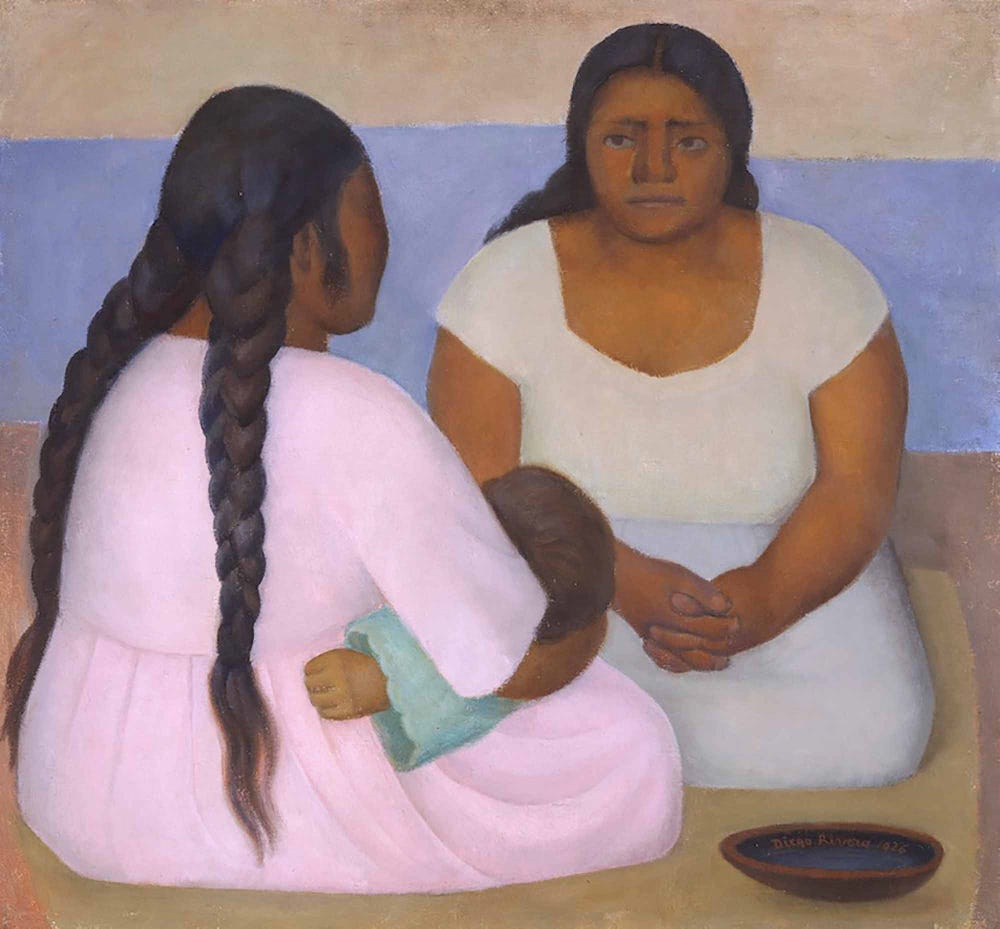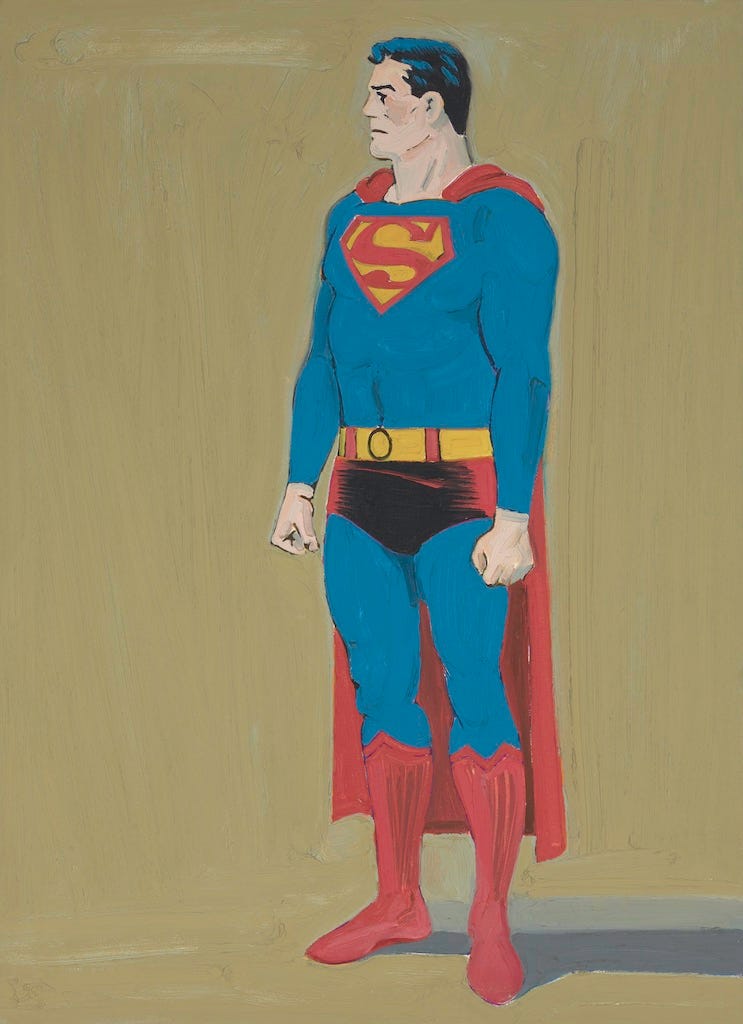Episode 3: Let’s Get Emotional
De'Yani: Can you tell me a time where you felt a strong emotion when looking at artwork?
Andrea: Yeah. I remember looking at an artwork by Félix González-Torres called, "Perfect Lovers." It's two clocks in sync next to each other, and it represents lovers, maybe soulmates, and the connection between them. The two clocks will eventually fall out of sync, but when they do, they can be reset. Sometimes you lose the spark, but if you're truly soulmates, you'll find your way back to each other. I just thought it was so cool and such a simple work of art that has a lot of meaning to it.
Ankhilan: There's this one work called, "Blood and Meat: Survival for the World," by Thornton Dial. It's featured in one of our other episodes called, "Material." Upon first look, I was drawn into the painting, not only because of its unique style, but also how honest the title was as well. In a way, I relate to the artist's feeling, that the world can be an unforgiving place. I also really liked how he was able to express himself through a piece full of chaos. What about you, De’Yani?
De'Yani: A few years ago, I went to the Smithsonian National Museum of African American History and Culture in Washington, DC. It was so breathtaking seeing African American history. One object that caught my attention was Emmett Till's casket. Till's family gave his casket to the museum so that people will know his story. Emmett Till was a teenage boy who was accused of whistling at a white woman in Mississippi in 1955. He was then hunted down by three men, beaten to death, shot in the head and then thrown in the river. When his mother buried her child, she knew it was time the world knew of her child's murder. Seeing his casket revealed to me, the struggles African American people have to go through. It was really moving, but also a traumatic experience for me. It's hard to see people that look like you go through so much while you're going through so much yourself. It was really hard for me to express my hurt because a lot of times, I can't show my emotions because people will assume I'm just being an emotional teenager. However, visiting the museum only made my hunger for change grow stronger.
Andrea: Yeah, and especially for teenagers like us, society makes letting our emotions seem like a sign of weakness, which is why oftentimes, we push and hide our feelings when instead, they should be taken seriously as they're an important part of understanding ourselves. Hi, I'm Andrea.
Ankhilan: I'm Ankhilan.
De'Yani: And I'm De’Yani. We're museum ambassadors at the Fine Arts Museums of San Francisco. Today, we'll be discussing three different artworks that represent and evoke intense emotional response, like obligation and love.
Ankhilan: What do you think of when you hear the word "superheroes"? From his humble start, Superman was first featured in comic strips in Cleveland, Ohio in 1933. Created from the imaginations of two teenage boys, Superman quickly became a comic book, animation, movie and pop culture phenomenon. Though it has been over 80 years since the creation of Superman, generations after generations just can't seem to get enough. Superman has been a part of almost every American childhood since the 1930s, including mine. I remember watching Justice League with my brothers and fighting about who's stronger: Batman or Superman?
Throughout American history, Superman has represented hope and justice during the toughest of times like the Great Depression, World War II and the Vietnam War.
What you're looking at is an oil painting called, Superman by Mel Ramos.
What do you see when you think of Superman? For me, I imagine a brave, heroic being who's ready to take on any evil coming his way and saves the civilians from the villain's vicious plan. But why does he look so different in this painting? I can see emotions in this painting that betrays Superman's reputation as the man of steel. From his facial expression to the way he is standing in this painting, everything screams worry, loneliness, and even wariness. Alone in the vacuum of space, Superman is gazing into the distance with clenched fists and rigid posture. It is almost like he's tired of saving humans, but has yet to retire because he's afraid of letting others down.
I can relate to this feeling. As a teen who will be graduating soon, I'm surrounded by expectations from my family, friends and especially myself. I can feel overwhelmed and lonely like Superman in this painting. Maybe Mel Ramos felt like this when he was painting this artwork too.
Thanks to his paintings of superheroes, famous icons and playful pinups, Mel Ramos is known as one of the artists associated with the pop art movement that became famous in the early 1960s. These artists use mass produced cultural objects to express their social critique of American culture. But I wonder how it was for Ramos during the beginning of his career.
From a young age, Mel knew that he wanted to be an artist and had the talent to do it. After graduating from Sacramento State University in 1957, Ramos was dead set on becoming an abstract expressionist. Abstract Expressionism is a style of art that uses abstraction to emphasize free, spontaneous and strong personal emotions. However, he was struggling to become a successful abstract expressionist.
Mel Ramos: I wasn't depressed enough to be a good abstract expressionist. I'm really an up guy, and I'm just going to do something that's fun and that I like. So I did a painting of Superman and my life changed.
Ankhilan: Right when the pop art movement gained popularity, Mel's painting of DC comic characters like Superman, Batman #2, and Aquagirl also gained popularity and changed his life forever. Back to the painting. I still find that a little strange that Superman, the hope and hero of America, is portrayed as lonely. What do you think? Did Mel's experience affect the way he represented Superman? Or maybe it is our own feelings that are reflected back to us in this artwork.
De'Yani: Diego Rivera's Two Women and a Child is a captivating piece, partly inspired by early Italian Renaissance art. The painting consists of two women sitting down facing each other, seemingly deep in conversation. The women are indigenous and are set in the empty room. The woman who has her back facing us, holds her child who is laying in his or her mother's lap. To me, it is simple, yet captivating.
I was taken aback by the amazing detail demonstrated in the woman's face. Rivera really showed the distress and seriousness in her face. The child's curled fist around the woman's side also adds to the sense of severity. At the same time, the work has an intimate and tender quality depicting what could be imagined as a peaceful moment. Rivera is able to display so much emotion through a limited palette. In a lot of artwork, vibrant colors are used to represent emotion, but Rivera's painting is more reserved using colors like beige, light blue, light purple and brown. Diego Rivera is considered by some, the greatest Mexican painter of the 20th century. He used his skills to re-introduce mural painting into modern art and architecture.
Rivera began studying in 1907 when he moved to Europe. It wasn't until he started studying Renaissance frescos from Italy that he found the inspiration he was looking for. Fresco is a technique where you paint water-based pigments on a damp plaster surface. Rivera then returned to Mexico with his desire to use that technique in representing the everyday lives of people. He also took inspiration from the political ideals of the Mexican Revolution and the Russian Revolution. Rivera took what he learned in his studies and painted murals depicting scenes from Mexican history. He wanted to make art that reflected the lives of the working class and native peoples in Mexico. Speaking to a friend of mine, Lupita Martinez about this painting, she drew attention to the fact that Diego Rivera chose to paint to indigenous women.
Lupita Martinez: My initial emotion was curiosity and feeling really excited that this painting was made of indigenous women because a lot of times in paintings and artworks, artworks tend to be very white and very Eurocentric, whereas this painting is centering Indigenous women.
De'Yani: Listening to Lupita really opened my eyes to how the art history was often taught is really Eurocentric, how people of color were almost never represented. Our conversation made me change my perspective. Now that I was able to understand what she sees, I can take that perspective and apply it to the art we see today.
Ankhilan: Art and emotion have always been linked to each other. With every artwork you lay your eyes on, you can feel a range of emotions from bored to inspire.
Andrea: Art has the power to make us feel a certain way, whether it be through an object bursting with colors or a visually subdued object. No matter what the art is, using our own emotions is a way that we can understand it.
De'Yani: Now that we've explored just three out of a million artworks, can you recall a time when art made you feel such strong emotions.




